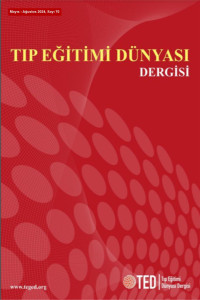Abstract
Introduction &Objective: Critical thinking consists of mental processes such as reasoning, analysis, and evaluation. It is an objective super-thinking way open to self-correction and change. The main component of the current education methods is the acquisition of critical thinking. Simulated patient applications in medical education is an effective method that enables the student to acquire cognitive and psychomotor behaviors with active participation in the learning process. The aim of this study is to determine the change in the critical thinking tendencies of the third-year students of Akdeniz University Faculty of Medicine before and after simulated patient applications.
Method: Third-year students of Akdeniz University Faculty of Medicine in the 2018-2019 academic year participated in the study. The students were asked to apply the Critical Thinking Disposition scale forms before the simulated patient applications. In the second stage of the study, the scale was reapplied to the students. The scale consists of 49 items. In our study, the results of the change between the first and the second applications of Critical Thinking Disposition scale were compared with the Paired Sample Test.
Results &conclusion: A total of 345 students participated in the study. The mean score obtained from the Critical Thinking Disposition scale of the whole group was 191.63 (SD = 21.07) in the fall term and 193.69 (SD = 23.63) in the spring term. Although there was an increase in mean values of CTHD scale, the difference was not statistically significant (t(344)=-1.09, p = 0.277). The multidimensional nature of critical thinking skills and the need for continuity in order to keep this skill sharp are considered effective on this result. Different applications can be added to the training program to develop this skill.
References
- 1. Şenşekerci E, Bilgin A. Critical thinking and its teaching. U.Ü. Fen-Edebiyat Fakültesi Sosyal Bilimler Dergisi. 2008; 1: 14.
- 2. Gupta M, Upshur R. Critical thinking in clinical medicine: what is it? Journal of Evaluation in Clinical Practice.2012; Oct;18(5):938-44.
- 3. Söylemez Y. Content analysis: critical thinking. Ekev Akademi Dergisi. 2016; 66.
Abstract
Giriş ve Amaç: Eleştirel düşünme; akıl yürütme, analiz ve değerlendirme gibi zihinsel süreçlerden oluşur. Kendi kendini düzeltmeye ve değişime açık nesnel üst düşünme biçimidir ve günümüz bilgi çağı için temel bir beceri olarak kabul edilmektedir. Mevcut eğitim yöntemlerinin temel bileşeni eleştirel düşünmenin kazanılmasının sağlanmasıdır. Tıp eğitiminde simüle hasta uygulamaları öğrencinin öğrenme sürecine aktif katılımı ile bilişsel ve psikomotor davranışların kazanılmasını sağlayan etkili bir eğitim yöntemidir. Aynı zamanda bu uygulama, öğrencilere teorik bilginin gerçek ortamdaki uygulamasının nasıl olabileceğini güvenli bir ortamda deneyimleme şansı vermektedir. Bu çalışmanın amacı, Akdeniz Üniversitesi Tıp Fakültesi dönem üç öğrencilerinin simüle hasta uygulaması öncesi ve sonrası eleştirel düşünme eğilimlerindeki değişimin saptanmasıdır.
Yöntem: 2018-2019 öğretim yılında Akdeniz Üniversitesi Tıp Fakültesi üçüncü sınıf öğrencileri çalışmaya katılmıştır. Öğrencilerden simüle hasta uygulaması öncesi Eleştirel Düşünme Eğilimi (EDE) ölçek formlarını uygulamaları istenmiştir. Çalışmanın ikinci aşamasında uygulama yapan öğrencilere ölçek bir kez daha uygulanmıştır. Ölçeğin geçerlilik ve güvenirlik çalışması 2016 yılında Semerci N. tarafından yapılmıştır. Ölçek çok boyutlu olup, 49 maddeden oluşmaktadır. Çalışmamızda birinci EDE ölçeği sonuçları ile ikinci EDE ölçeği arasındaki değişimin sonuçları Paired Sample Test ile karşılaştırılmıştır.
Bulgular ve sonuç: Çalışmaya toplam 345 öğrenci katılmıştır. Tüm grubun EDE ölçeği ortanca değeri ilk dönem 191.63 (SS = 21.07), ikinci dönem 193.69 (SS = 23.63) bulunmuştur. EDE ölçeğinin ortalama değerlerinde artış olmasına rağmen, fark istatistiksel olarak anlamlı değildir (t(344) = -1.09, p = 0.277). Eleştirel düşünme becerisinin çok boyutlu olmasının ve sürekliliğe ihtiyaç duymasının sonuç üzerinde etkili olduğu düşünülmektedir. Eleştirel düşünmenin kademeli gelişimi göz önüne alınarak eğitim programı içerisine bu becerinin geliştirilmesi için farklı uygulamalar eklenebilir.
Keywords
References
- 1. Şenşekerci E, Bilgin A. Critical thinking and its teaching. U.Ü. Fen-Edebiyat Fakültesi Sosyal Bilimler Dergisi. 2008; 1: 14.
- 2. Gupta M, Upshur R. Critical thinking in clinical medicine: what is it? Journal of Evaluation in Clinical Practice.2012; Oct;18(5):938-44.
- 3. Söylemez Y. Content analysis: critical thinking. Ekev Akademi Dergisi. 2016; 66.
Details
| Primary Language | English |
|---|---|
| Subjects | Medical Education |
| Journal Section | Original Article |
| Authors | |
| Publication Date | August 31, 2024 |
| Submission Date | June 12, 2024 |
| Acceptance Date | July 8, 2024 |
| Published in Issue | Year 2024 Volume: 23 Issue: 70 |

